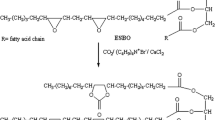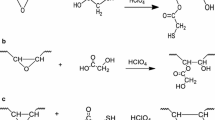Abstract
This work demonstrates the synthesis of bio-based polyurethane from soybean oil and glycerol derived highly branched structure via non-isocyanate route. The soybean oil based cyclic carbonates were synthesized by coupling of CO2 with epoxidized soybean oil. In the second step, glycerol derived highly branched cyclic carbonate was synthesized from diglycidal ether of bisphenol A (DGEBA) and CO2. The structure of prepared monomer was confirmed from FT-IR, 1H and 13C NMR spectra. Then a series of non-isocyanate polyurethanes (NIPUs) were synthesized. They exhibited satisfactory mechanical properties (Tensile strength = 10.1 MPa) and thermal stability (283 °C). These results indicate the prospect of this eco-friendly approach for preparing renewable NIPU without the use of isocyanate.










Similar content being viewed by others
References
Gandini A, Lacerda TM, Carvalho AJF, Trovatti E (2016) Progress of polymers from renewable resources: Furans, vegetable oils, and polysaccharides. Chem Rev 116:1637–1669
Gandini A, Lacerda TM (2015) From monomers to polymers from renewable resources: Recent advances. Prog Polym Sci 48:1–39
Zhu Y, Romain C, Williams CK (2016) Sustainable polymers from renewable resources. Nature 540:354–362
Gandini A (2008) Polymers from renewable resources: A challenge for the future of macromolecular materials. Macromolecules 41:9491–9504
Meier MAR, Metzger JO, Schubert US (2007) Plant oil renewable resources as green alternatives in polymer science. Chem Soc Rev 36:1788–1802
Sawpan MA (2018) Polyurethanes from vegetable oils and applications: a review. J Polym Res 25:184
Montero de Espinosa L, Meier MAR (2011) Plant oils: The perfect renewable resource for polymer science?! Eur Polym J 47(5):837–852
Pelufo DI, Neto SC, Gobbo RCB, dos Santos AJ, Terezo AJ, de Siqueira AB (2020) Kinetic study of the thermal decomposition of castor oil based polyurethane. J Polym Res 27:143
Gogoi P, Boruah M, Sharma S (2015) Dolui SK (2015) Blends of epoxidized alkyd resins based on jatropha oil and the epoxidized oil cured with aqueous citric acid solution: A Green technology approach. ACS Sustain Chem Eng 3(2):261–268
Zhu J, Chandrashekhara K, Flanigan V, Kapila S (2004) Curing and mechanical characterization of a soy-based epoxy resin system. J Appl Polym Sci 91:3513–3518
Guo A, Javni I, Petrovic Z (2000) Rigid polyurethane foams based on soybean oil. J Appl Polym Sci 77:467–473
Król P (2007) Synthesis methods, chemical structures and phase structures of linear polyurethanes. Properties and applications of linear polyurethanes in polyurethane elastomers, copolymers and ionomers. Prog Mat Sci 52:915–1015
Zdrahala RJ, Zdrahala IJ (1999) Biomedical applications of polyurethanes: A Review of past promises, present realities, and a vibrant future. J Biomater Appl 14:67–90
Chattopadhyay DK, Raju KVSN (2007) Structural engineering of polyurethane coatings for high performance applications. Prog Polym Sci 32:352–418
Pelrine RE, Kornbluh RD, Joseph JP (1998) Electrostriction of polymer dielectrics with compliant electrodes as a means of actuation. Sens Actuator A Phys 64:77–85
Carré C, Bonnet L, Avérous L (2014) Original biobased nonisocyanate polyurethanes: solvent-and catalyst-free synthesis, thermal properties and rheological behaviour. RSC Adv 4:54018–54025
Carré C, Ecochard Y, Caillol S, Averous L (2019) From the synthesis of biobased cyclic carbonate to polyhydroxyurethanes: A promising route towards renewable NonIsocyanate Polyurethanes. Chem Sus Chem 12:3410–3430
Cornille A, Auvergne R, Figovsky O, Boutevin B, Caillol S (2017) A perspective approach to sustainable routes for non-isocyanate polyurethanes. Eur Polym J 87:535–552
Maisonneuve L, Lamarzelle O, Rix E, Grau E, Cramail H (2015) Isocyanate-free routes to polyurethanes and poly(hydroxy urethane)s. Chem Rev 115:12407–12439
Furtwengler P, Avérous L (2018) From D-sorbitol to five-membered bis (cyclo-carbonate) as a platform molecule for the synthesis of different original biobased chemicals and polymers. Sci Rep 8:1–14
North M, Pasquale R (2009) Mechanism of cyclic carbonate synthesis from epoxides and CO2. Angew Chem Int Ed 48:2946–2948
Meléndez J, North M, Villuendas P (2009) One-component catalysts for cyclic carbonate synthesis. Chem Comm 18:2577
Meléndez J, North M, Villuendas P, Young C (2011) One-component bimetallic aluminium(salen)-based catalysts for cyclic carbonate synthesis and their immobilization. Dalton Trans 40:3885–3902
Tamami B, Sohn S, Wilkes GL (2004) Incorporation of carbon dioxide into soybean oil and subsequent preparation and studies of nonisocyanate polyurethane networks. J Appl Polym Sci 92:883–891
Poussard L, Mariage J, Grignard B, Detrembleur C, Jérôme C, Calberg C, Heinrichs B, De Winter J, Gerbaux P, Raquez JM, Bonnaud L, Dubois P (2016) Non-isocyanate polyurethanes from carbonated soybean oil using monomeric or oligomeric diamines to achieve thermosets or thermoplastics. Macromolecules 49:2162–2171
Foltran S, Maisonneuve L, Cloutet E, Gadenne B, Alfos C, Tassaing T, Cramail H (2012) Solubility in CO2 and swelling studies by in situ IR spectroscopy of vegetable-based epoxidized oils as polyurethane precursors. Polym Chem 3:525–532
Malik M, Kaur R (2018) Synthesis of NIPU by the carbonation of canola oil using highly efficient 5, 10, 15-tris (pentafluorophenyl) corrolato-manganese (III) complex as novel catalyst. Polym Adv Technol 29:1078–1085
Javni I, Hong DP, Petrović ZS (2008) Soy-based polyurethanes by nonisocyanate route. J Appl Polym Sci 108:3867–3875
Samanta S, Selvakumar S, Bahr J, Wickramaratne DS, Sibi M, Chisholm BJ (2016) Synthesis and characterization of polyurethane networks derived from soybean-oil-based cyclic carbonates and bioderivable diamines. ACS Sustain Chem Eng 4:6551–6561
Kathalewar M, Sabnis A, D’Mello D (2014) Isocyanate free polyurethanes from new CNSL based bis-cyclic carbonate and its application in coatings. Eur Polym J 57:99–108
Janvier M, Ducrot PH, Allais F (2017) Isocyanate-free synthesis and characterization of renewable poly(hydroxy)urethanes from syringaresinol. ACS Sustain Chem Eng 5:8648–8656
Ke J, Li X, Wang F, Jiang S, Kang M, Wang J, Li Q, Wang Z (2017) Non-isocyanate polyurethane/epoxy hybrid materials with different and controlled architectures prepared from a CO2-sourced monomer and epoxy via an environmentally-friendly route. RSC Adv 7:28841–28852
Wazarkar K, Kathalewar M, Sabnis A (2016) Development of epoxy-urethane hybrid coatings via non-isocyanate route. Eur Polym J 84:812–827
Caminade AM, Yan D, Smith DK (2015) Dendrimers and hyperbranched polymers. Chem Soc Rev 44:3870–3873
Gao C, Yan D (2004) Hyperbranched polymers: From synthesis to applications. Prog Polym Sci 29:183–275
Voit BI, Lederer A (2009) Hyperbranched and highly branched polymer architectures-synthetic strategies and major characterization aspects. Chem Rev 109(11):5924–5973
Zhang H, Patel A, Gaharwar AK, Mihaila SM, Iviglia G, Mukundan S, Bae H, Yang H, Khademhosseini A (2013) Hyperbranched polyester hydrogels with controlled drug release and cell adhesion properties. Biomacromol 14:1299–1310
De B, Gupta K, Mandal M, Karak N (2014) Biodegradable hyperbranched epoxy from castor oil-based hyperbranched polyester polyol. ACS Sustain Chem Eng 2(3):445–453
De B, Karak N (2015) Ultralow dielectric, high performing hyperbranched epoxy thermosets: synthesis, characterization and property evaluation. RSC Adv 5(44):35080–35088
Jena KK, Narayan R, Raju KVSN (2010) Hyperbranched polyester based on the core + AB2 approach: Synthesis and structural investigation. J Appl Polym Sci 118:280–290
Dhevi DM, Jaisankar SN, Pathak M (2013) Effect of new hyperbranched polyester of varying generations on toughening of epoxy resin through interpenetrating polymer networks using urethane linkages. Eur Polym J 49:3561–3572
Acknowledgments
S. Doley gratefully acknowledges the University Grant Commission, India for providing financial support.
Author information
Authors and Affiliations
Corresponding author
Additional information
Publisher's Note
Springer Nature remains neutral with regard to jurisdictional claims in published maps and institutional affiliations.
Rights and permissions
About this article
Cite this article
Doley, S., Bora, A., Saikia, P. et al. Blending of cyclic carbonate based on soybean oil and glycerol: a non-isocyanate approach towards the synthesis of polyurethane with high performance. J Polym Res 28, 146 (2021). https://doi.org/10.1007/s10965-021-02485-2
Received:
Accepted:
Published:
DOI: https://doi.org/10.1007/s10965-021-02485-2




